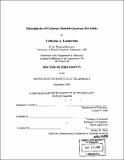Photophysics of cadmium selenide quantum dot solids
Author(s)
Leatherdale, Catherine A. (Catherine Anne), 1972-
DownloadFull printable version (8.759Mb)
Other Contributors
Massachusetts Institute of Technology. Dept. of Chemistry.
Advisor
Moungi G. Bawendi.
Terms of use
Metadata
Show full item recordAbstract
Semiconductor quantum dots or nanocrystals have size dependent optical and electronic properties that arise from quantum confinement. While the quantum size effect is reasonably well understood, the effect of abrupt interface between the nanocrystal and its dielectric environment is not. In this thesis we study how the dielectric environment affects the quantum dot electronic structure, the optical absorption ~ross-section, charge separation, and transport in cadmium selenide colloidal quantum dots. The electronic states and optical absorption cross-section are found to be less sensitive to changes in the dielectric environment than predicted from theory unless screening from the ligand shell is taken into account. The absolute absorption cross section is measured as a function of quantum dot size; excellent agreement with theory is obtained for absorption far above the band edge. Three-dimensional close packed solids of quantum dots are predicted to act as model artificial solids. Optical absorption measurements indicate that the electronic states of CdSe quantum dots separated by 11 angstroms or more are essentially uncoupled. Photoconductivity measurements suggest that photoexcited quantum confined excitons are ionized by the applied field with a rate that depends on both the size and surface passivation of the quantum dots. The charge generation efficiency decreases with increasing temperature as non-radiative and radiative recombination pathways increasingly compete with charge separation. A simple tunneling model for the initial charge separation step is presented that qualitatively reproduces both the size and surface dependence of the photoconductivity as a function of applied electric field. Finally, we report observations of amplified spontaneous emission from quantum dot solids. The stimulated emission is tunable with quantum dot size and does not sensitively depend upon surface passivation. These measurements demonstrate the feasibility of nanocrystal quantum dot lasers and amplifiers.
Description
Thesis (Ph.D.)--Massachusetts Institute of Technology, Dept. of Chemistry, 2000. Includes bibliographical references.
Date issued
2000Department
Massachusetts Institute of Technology. Department of ChemistryPublisher
Massachusetts Institute of Technology
Keywords
Chemistry.